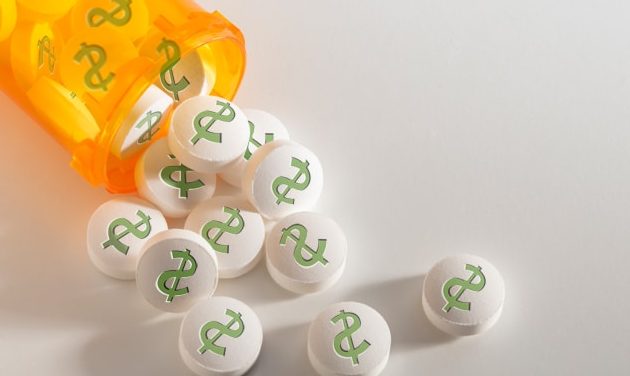### The Real Cost of Prescription Drugs Without Insurance
Without the safety net of insurance, prescription medications can be prohibitively costly. Pharmacies will often charge what’s called the “Usual and Customary Price.” According to the 2020 United States Census data, approximately 8.6% of Americans are without medical insurance, which dramatically hikes their healthcare expenses.
A study regarding the [cost of prescription drugs in the US](https://bridgecanhealth.com/prescription-drugs/) found that over 75% of adults view prescription medications as unaffordable. Alarmingly, one in three adults has had to cease taking their prescribed medicines due to financial difficulties.
The Organization for Economic Cooperation and Development (OECD) highlights that **Americans spend an average of $1,126 per capita on prescription medicines**—more than double the average expenditure ($552) in other OECD countries. This figure encompasses both insurer payments and out-of-pocket costs incurred by patients for prescription renewals.
Data indicates that U.S. expenditure on prescribed medications soared by 69% from 2004 to 2019. This escalation is substantially higher than the 41% rise observed in other nations. Generally, **Americans face steeper out-of-pocket costs for prescription drugs** compared to those in similar countries without insurance.
## Understanding High Drug Prices in the U.S.
Several elements drive the steep costs of prescription medications in the United States:
1. A lack of transparency in drug pricing
2. A less competitive pharmaceutical market due to mergers and acquisitions
3. Limited negotiation power of entities like Medicare
4. An increase in overall spending, influenced by the type and number of prescriptions, particularly high-cost specialty drugs
These high expenses profoundly impact uninsured Americans who rely on medication, as well as the overall U.S. budget and economic health.
## Comparing Drug Prices: U.S. vs. Canada
The cost differences between the U.S. and other countries are stark. Canada, for instance, has managed to keep pharmaceutical costs lower, even for individuals without provincial or private insurance coverage.
In Canada, price gouging is illegal. The Patented Medicine Prices Review Board ensures that new brand-name drugs are not excessively priced and controls price hikes within inflation rates. This regulatory environment is one reason why Canadian drugs are more affordable compared to those in the U.S.
Below is a comparison of prices for some commonly prescribed medications in the U.S. versus Canada, illustrating potential savings.
| Drug Name | U.S. Price | Canada Price | Savings (%) |
| Januvia (Type 2 Diabetes) | $1,355.74 | $371.58 | 73% |
| Spiriva (COPD) | $1,306.05 | $281.58 | 78% |
| Entocort (Crohn’s Disease, Ulcerative Colitis) | $2,057.41 | $238.27 | 88% |
| Crestor (Cholesterol) | $731.17 | $210.52 | 71% |
| Flovent Diskus (Asthma) | $192.92 | $59.63 | 69% |
| Xarelto (Blood Clots) | $1,347.98 | $474.29 | 65% |
| Premarin (Estrogen Replacement Therapy) | $496.99 | $96.15 | 81% |
| Dexilant (Stomach & Esophageal Issues) | $622.24 | $272.98 | 56% |
| Synthroid (Hormone Deficiency) | $118.15 | $35.17 | 70% |
| EpiPen (Allergies) | $607.36 | $276.63 | 54% |
This comparison indicates potential savings of 50% to 80% on prescription drugs when comparing U.S. prices to those in Canada.
### Debunking Prescription Drug Myths
Surprisingly, the most rapidly growing drugs in the U.S. aren’t illegal substances like cocaine or heroin but prescription medications. This has been one of the unexpected [discoveries](https://www.samhsa.gov/homelessness-programs-resources/hpr-resources/rise-prescription-drug-misuse-abuse-impacting-teens) for researchers in the pharmaceutical field.
Consider the following statements about prescription medications. Which one is **FALSE**?
1. Expensive drugs **equate** to better drugs
2. Brand-name drugs are **similar** to generics
3. Only brand-name drug prices are getting pricier
4. Your physician **can’t affect** what you pay for your medicine
5. Drug company **discounts will save you** money
If you answered **FALSE** to all of the above, you’re correct. These statements are widespread myths about prescription drug costs in the U.S.
**Fact #1**: Generic drugs, despite being cheaper, are designed to provide the same safety, strength, quality, and performance as brand-name variants.
**Fact #2**: While generics contain the same active ingredients as brand-name drugs, they might differ in aesthetics such as flavor and color.
**Fact #3**: Though brand-name drugs are typically more expensive, generic drug prices have also been increasing. A 2016 Government Accountability Office report showed that 300 generic drugs doubled in price the previous year; however, they are still cheaper than brand-name drugs.
**Fact #4**: Having detailed conversations with your physician about medical options can save you money. If a drug is too expensive, your doctor might suggest more affordable and equally effective alternatives.
